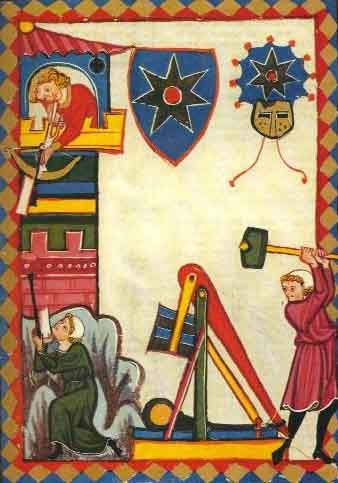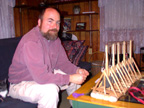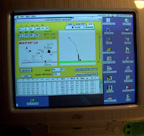|
The Tormentorum P-CCXXXVIII  Displayed at the Northern Lights Arts & Science Pentathlon |
|
The Tormentorum P-CCXXXVIII won the
Armor and Weapons category at the Northern Lights Arts and Sciences
Pentathlon hosted by the Shire of Panther Vale on March 24th,
2001. The following, regrettably text-heavy, documentation was
submitted with the entry. It is provided here for the benefit
any who might be interested in the subject, and perhaps to demonstrate
to judge R. B. that, though mislaid, the documentation was not
altogether neglected . . . Grand Tormentor of Freegate Click on the thumbnail pictures to view larger images. |
|
Trebuchets were once the ultimate weapons of siege combat. In widespread use throughout the Dark Ages, they were often erected beyond the effective range of enemy archers, and used to reduce castle walls to rubble. Far superior in power and accuracy to the catapult, the largest specimens were reported to throw 250 pound stones as far as 300 yards. For centuries, their development drove the design of ever greater fortresses, and their use was the very definition of siege warfare. Many of Europe's greatest cities, even Paris1, once bore the unkind ministrations of the Grand Tormentor2 and his massive siege engines, as History itself still bears their mark. The only ancient trebuchet known to have survived to modern times was as quickly dismantled by the peasants who discovered it, and used for firewood3. As a result, much of what we know about their construction and use necessarily comes to us from such illustrations as this excellent 14th century example4: |
 "Von Trostberg's Castle is besieged" |
Not frightfully helpful, is it? Was this trebuchet truly no taller than a man? What was it made of? Was its counterpoise a wooden box of dirt, or a stack of metal plates? Was the figure wielding the mallet preparing to trip a trigger which the artist neglected, or was he just another frustrated engineer? As is often the case, our artist knew little about the functional aspects of his subject, and perhaps cared less. The use of 'scale' as a drawing tool came into accepted use only a century later, along with such outré concepts as 'perspective'5 and 'blue skies'6. With the universal lack of meaningful detail in contemporary documentation, modern trebuchet reconstructions, such as the diminutive Tormentorum P-CCXXXVIII before you, are therefore the result of historical research, science, and conjecture. |
| 1 Abbo de St. Germain, app. 890: De belle Parisiato 2 Master of siege engines 3 Rathgen, B., 1928: Das Geschutz im Mittelalter. Berlin 4 Artist unknown, app. 1330 |
5 Filippo Brunelleschi is credited with the earliest
experiments in perspective, app. 1420. 6 The sky is either gilded or yellow in Medieval art; never blue. |





